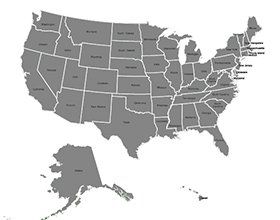FREQUENTLY ASKED QUESTIONS
FAQ
What is a Deductible?
A deductible is the amount you pay out of pocket before the insurance plan starts to pay. Typically, services that are performed outside of a doctor’s office setting will be subject to a deductible.
What is an Out of Pocket Maximum?
It is the maximum amount you pay for covered services during the plan year. Deductibles, co-insurance and copays all count toward the out of pocket maximum.
What is the difference between a Copay and Co-Insurance?
A copay is a flat dollar amount paid for specific services, such as an office visit or prescription medications. Co-insurance is the percentage you pay for services after you have satisfied your deductible.
Should I use Urgent Care or an Emergency Room?
This will depend on the services needed. If you have a sprain, need stiches, have a cold or the flu, you should utilize an urgent care facility. For life-threatening injuries or illnesses such as a heart attack or stroke, you should proceed to the emergency room.
Should I choose an In-Network or Out-of-Network provider?
In almost all cases, it will be more beneficial to you if you choose an in-network provider. In-network providers are doctors and hospitals that are contracted by the insurance company to perform medical services at the lowest possible cost, while delivering the highest quality care. While certain types of coverage, like a PPO, will allow you to choose an in-network or out-of-network provider, some types of coverage, like an HMO, will limit you to in-network providers only. When seeking emergency services for a life-threatening injury or illness, it is recommended that you go to the nearest emergency room. Emergency services are treated as in-network. To get a complete list of your in-network providers, please visit your insurance carrier’s website or call the number on the back of your member ID card for assistance.
What if I go to an In-Network facility and an Out-of-Network doctor performs a procedure?
Unfortunately, this seems to be a growing trend. You may receive an invoice from an out-of-network anesthesiologist, radiologist or pathologist, along with a rejection of services from the insurance company because an out-of-network doctor performed your procedure while you were hospitalized at an in-network facility. If this happens, please contact the insurance company and inform them of the issue. It is also a good idea to contact our office so we can work with the carrier from our end as well. The insurance company’s position is that it is your responsibility to know who will be performing your procedures and whether or not they are in-network. However, that is not always possible in certain situations. We will work with you and the insurance carrier to reach the best outcome for you.
Why do I have so many prescription copay levels?
Prescription prices are rising every year, so it is important for you to know how your insurance company covers your medications. Medications are typically broken down into four categories: Generic, Preferred brand name, Non-Preferred brand name and Specialty. Most insurance companies will try to steer your prescription use to either Generic or Preferred brand names. Non-preferred brand names typically have an alternative that is just as safe and effective, but more cost efficient. Please note, the medication you are currently taking today can change tiers throughout the year. If this does happen, it may require you to have a conversation with your doctor about a more affordable alternative. To get an up to date prescription drug list, please visit your insurance company’s website or call the number on the back of your member ID card for assistance.
When will I receive my ID card?
Once an enrollment form is processed, an ID card is issued by the insurance carrier. Once mailed, they generally take 7-10 days to arrive. Your card may not arrive until after the actual effective date of your coverage depending on when your information is received and when the card is mailed. If you find that you need to seek services and you do not have your card, you can contact our office and we will be able to provide you with your member ID number. In some cases, you can register on the insurance company’s website and print a card for your temporary use. You may also be able to access your card on your phone by downloading and registering on the carrier’s app.
What is a Health Savings Account (HSA)?
A HSA is a medical savings account that is available to you if you are enrolled in a qualified high deductible health plan. With a HSA, you can save money on a pre-tax basis and use that money to pay for future medical expenses. An important features of a HSA is that you can roll your remaining account balance over from year to year. For more information, please contact our office.
What is a Flexible Spending account (FSA)?
A FSA is a front-loaded employer sponsored account that allows employees to save money on a pre-tax basis to pay for medical expenses during the plan year. Most FSA’s are use it or lose it accounts. This means that any funds not used by the end of the plan year will be lost. Often bundled with a FSA is a Dependent Care Account (DCA). A DCA allows the individual to save money on a pre-tax basis for qualified child or adult care services. Like a FSA, the DCA is a use it or lose it benefit. Any unused funds at the end of the plan year will be lost.
What is a Health Reimbursement Account (HRA)?
A HRA is employer funded account that reimburses employees on a tax-free basis for qualified medical expenses.
What is a Point of Service (POS) plan?
A POS plan is like a HMO health plan in that it allows employees to utilize out-of-network doctors and hospitals if needed. The out-of-network facilities are subject to larger deductibles and co-insurance.
What is an Exclusive Provider Organization (EPO)?
An EPO is a cross between a PPO and a HMO. The EPO allows you to have access to a large network of doctors and hospitals like a PPO, however it does not provide any out-of-network services like an HMO (except for emergencies).
What is the Consolidated Omnibus Budget Reconciliation Act (COBRA)?
COBRA is a federal law that allows you to maintain your current health insurance coverage after you leave employment. Your employer must have 20 or more active employees in order for you to be eligible for COBRA. Depending on the situation, your coverage could be continued for 18-36 months.
Until what age can you have children on coverage?
According to the Affordable Care Act (ACA), dependents can remain on their parent’s coverage until age 26. Certain carriers will end coverage on the last day of the month they turn 26 and others will end coverage on 12/31 of the year they turn 26. Please see your plan documents for more details. When covering your dependent child there are no other requirements, meaning they can be married or even living out of state and have their own coverage, and still be covered under you plan. It is your right to be able to keep them on your plan until they are 26 years old.
How does the enrollment process work?
The enrollment process does vary between employers. Some use paper format and others use online enrollment tools. Regardless of how your employer offers coverage, it is important that you review your options and either elect or decline benefits offered each year. Please remember that having a valid waiver is as important as electing a benefit.
How do I dispute a claim?
In today’s HIPAA compliant world, it is always best to first contact the insurance company to discuss a claim. If you cannot get a resolution on the claim, we suggest you contact our office and we will be happy to get involved in the process on your behalf. In order for us to get involved in the claim we will need your name, date of birth, social security number, the date and place of service, and approximate amount of the claim.
Do I need to ask about Preauthorization?
Most health insurance programs require preauthorization for non-emergency surgery and high-dollar diagnostic testing. While most doctors take care of the preauthorization process, it is ultimately your responsibility to make sure that preauthorization is approved before any services are performed. Even when admitted on emergency basis, the insurance carrier likes to know of the admission within 24-48 hours.



